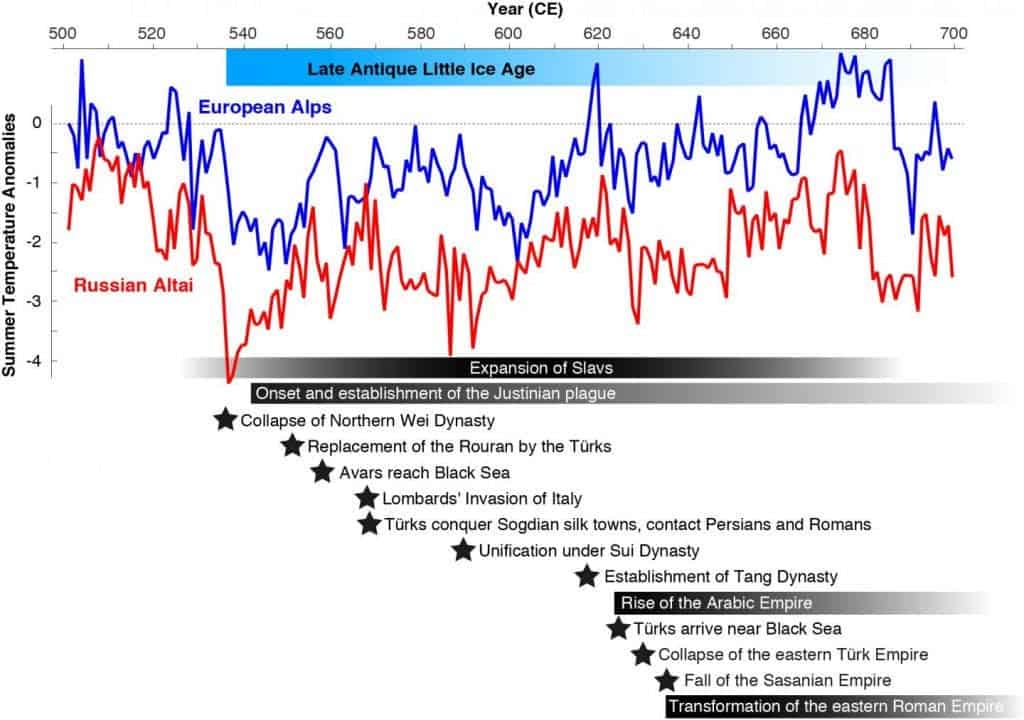A period of significant cooling from 536 to 660 AD brought forth massive societal changes in Europe and Asia, a new study found. The cooling, caused by volcanic activity, coincided with a massive plague, the decline of the Byzantine Empire and the spread of Slavic and Arabic people.

Credit: Past Global Changes International Project Office
It is well known that volcanic activity can lead to colder climate, by ejecting aerosols which block some of the Sun’s energy. Dendroclimatologist Ulf Büntgen and his team found that three volcanic eruptions, in 536, 540 and 547 AD, led to a much colder climate than was normal in the past 2000 years. By studying tree rings, they found a period of pronounced cooling from about 536 to 660. This period, coincidentally or not, was one of major struggle in Europe and Asia.
“This was the most dramatic cooling in the Northern Hemisphere in the past 2000 years,” he said. Volcanic aerosols can remain in the air for decades, keeping global temperatures low.
During the “Late Antique Little Ice Age,” as they’ve called it, a dramatic plague of unprecedented proportions spread through Europe and Asia, especially through the Byzantine Empire. The diseases seems to have originated from China, but for some reason, it struck the empire extremely hard. The plague killed 25 million people in the outbreak alone. The emperor himself contacted the plague, though he survived it. The plague returned periodically until the 8th century.
For the Byzantines it was a dramatic blow – not only because the people who were killed, but also because of the decline of agriculture. The plague caused tax revenues to decline and struck a fierce blow to Mediterranean trade. The already stretched empire, fighting enemies on all fronts began to decline, marking the start of a period some call the “Dark Ages”.
But it wasn’t only the Byzantines that were affected – some rejoiced in this cooling. The Arabs, fighting the Empire on the eastern side, rejoiced at the reduced temperatures and increased rainfall brought by the climate shift. They thrived and established the basis of an empire of their own.
Some scholars have argued that the plague facilitated the Anglo-Saxon conquest of Britain, after years in which the Saxons were contained. Maelgwn, king of Gwynedd and a fierce opponent for the Saxons was also killed by the plague. In cooler areas, several tribes migrated towards China, driven away by the cold. This created hostilities between the local ruling powers and these migrating tribes. An alliance between steppe populations and Eastern Romans ultimately destroyed the Sasanian Empire of Persia.
But was it indeed, the climate change that brought in all these things? That’s too bold of a statement to make right now.
“With so many variables, we must remain cautious about environmental cause and political effect, but it is striking how closely this climate change aligns with major upheavals across several regions,” added Büntgen.
But it seems reasonable to suspect that the shifting climate brought in at least some changes. Some of the unusual events that happened in that period seem more logical considering this shift.
“We can learn something from the speed and scale of the transformations that took place at that time,” he said.
He and his team analyzed tree rings from the Russian Altai Mountains and the European Alps to show that this interval was unusually cool throughout Europe and Asia. Tree rings are an accurate indicator of summer temperature.
Journal Reference: Cooling and societal change during the Late Antique Little Ice Age from 536 to around 660 CE.






